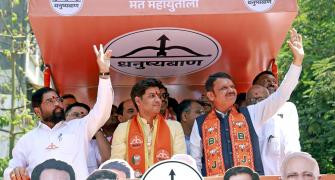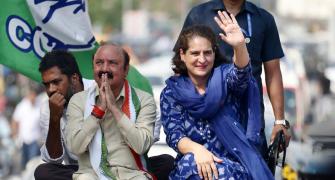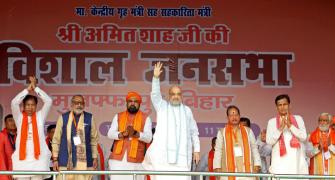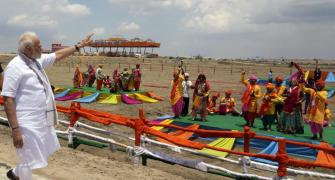The United Progressive Alliance has had mixed fortunes as it completes one year in power. Even though it has managed to keep inflation in check, it is still a cause for worry. Industrial progress has been better than in 2003-04, but core sector growth shows signs of slowing down.
On the upside, export growth has been better than in 2003-04 and the economy is slated to grow at 6.9 per cent in 2004-05, much better than was initially expected.
The Sensex, which had crashed 329.6 points to 5,069.87 on May 14, 2004 after announcements of privatisation by the Left parties, closed at 6,451.54 on May 13, 2005.
|
UPA Report Card | ||
|
Growth rates (%) | ||
|
2003-04 |
2004-05 | |
|
WPI-based inflation |
4.6 |
6 |
|
Index of industrial production |
7 |
8 |
|
Index of infrastructure industries |
6.2 |
4.4 |
|
Exports |
21.3 |
24.4 |
|
Gross domestic product |
8.5 |
6.9* |
|
Fiscal deficit as percentage of GDP |
4.5 |
4.5** |
|
*expected |
** Revised estimates | |
|
Sensex |
5,069.87 (on May 14, 2004) | |
|
6,451.54 (on May 13, 2005) | ||
The index of industrial production, a measure of how the industrial sector has performed, reported a growth of 8 per cent in 2004-05, up from 7 per cent in 2003-04. Manufacturing sector growth was up at 8.8 per cent, compared with 7.4 per cent in 2003-04.
Another good news is that exports, which grew at 21.31 per cent in 2003-04, grew further at 24.41 per cent in 2004-05. As almost 20 per cent of manufacturing are exported, it is a good sign for the industrial sector.
However, with growth in major export markets expected to slow down in 2005-06, the prognosis on that front is not too good either.
On the downside, deficits will increase, but that is in 2005-06. In 2004-05, the UPA managed to maintain fiscal deficit at 4.5 per cent of GDP, the same as in 2003-04.
However, in April-February 2004-05, fiscal deficit was 84 per cent of the Budget estimates compared with 72 per cent in the corresponding period last year. Likewise, revenue deficit was 121.7 per cent of the Budget estimates, compared with 83.1 per cent in the corresponding period in 2003-04.
In 2005-06, however, the government has put a pause on the Fiscal Responsibility and Budget Management targets, citing the recommendations of the Twelfth Finance Commission, which suggests hiking grants to states and stopping the practice of giving central loans. The Budget estimate puts fiscal deficit at Rs 1,51,144 crore (Rs 1511.44 billion), 4.3 per cent of the GDP.
The numbers put out in Budget 2005-06, however, have estimated a lower level of expenditure than the government may actually have to undertake, indicating that fiscal deficit can end up even higher.
Inflation, which is a measure of the general increase in prices, had crossed 8 per cent in August last year mainly on account of the rising international prices of oil and steel. The government took various steps, including duty cuts, to control it and brought it down to below 5 per cent in February 2005.
However, April onwards, the general price level has begun to rise again. Hikes in international oil prices have not been passed on to the domestic consumer and the move is bleeding the oil PSUs.
However, if the government does finally pass it on (it is only likely to do so partially), inflation will remain relatively low (around 6 per cent) on account of the high-base effect.
The index of core infrastructure industries, a group of six industries -- including coal, steel, cement and petroleum products -- which constitute a significant portion of the IIP, however, grew 4.4 per cent against 6.2 per cent in 2003-04. The index showed a 0.6 per cent fall in production in these sectors in February 2005 and only 3.7 per cent growth in March 2005.
GDP, the total value of goods and services produced each year by a country, is expected to grow 6.9 per cent in 2004-05, mainly on account of better-than-expected growth in agriculture. This growth figure is on top of an 8.5 per cent growth in 2003-04.
The first of a five-part series on how the Manmohan Singh government has managed the economy








